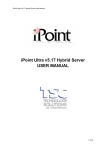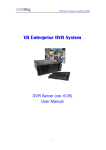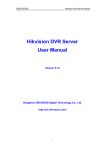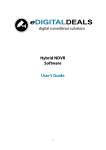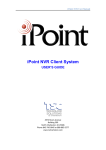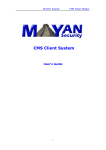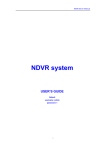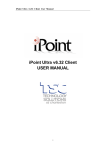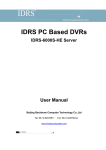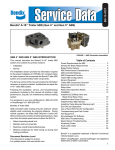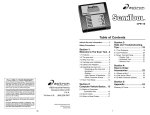Download iPoint Ultra v6.10B Hybrid Server USER MANUAL
Transcript
iPoint Ultra v6.10B Hybrid Server User Manual iPoint Ultra v6.10B Hybrid Server USER MANUAL 1 of 86 iPoint Ultra v6.10B Hybrid Server User Manual Table of Contents Introduction: ............................................................................................................. 4 System Features: ....................................................................................................... 4 1. 1.1. Start Up and Main Interface............................................................................ 5 Start Up.......................................................................................................... 5 1.2 Main Interface ................................................................................................ 6 1.2.1 Show Tips ................................................................................................... 6 1.2.2 Screen Menu .............................................................................................. 6 1.2.3 Interface Description................................................................................... 9 1.2.4 System Menu............................................................................................ 15 1.2.5 Motion Detection Area & Cover Setup ...................................................... 18 1.2.6 Network Panel .......................................................................................... 22 1.2.7 PTZ Control Panel .................................................................................... 22 1.2.8 Color and Audio Adjustment ..................................................................... 27 1.2.9 Matrix & Display........................................................................................ 27 1.2.10 DI/DO Control ........................................................................................... 28 2 Local Setup ................................................................................................... 29 2.1 2.1.1 2.1.2 2.1.3 System Setup .............................................................................................. 29 System Setup ........................................................................................... 29 Network Setup .......................................................................................... 30 Boot Setup................................................................................................ 32 2.2 2.2.1 2.2.2 Camera Setup.............................................................................................. 33 Camera Setup .......................................................................................... 33 Group Setup ............................................................................................. 37 2.3 2.3.1 2.3.2 Sensor Setup ............................................................................................... 38 Sensor Setup............................................................................................ 38 Group setup.............................................................................................. 39 2.4 2.4.1 2.4.2 PTZ & Linkage Setup................................................................................... 40 PTZ Protocol Setup .................................................................................. 40 Motion Detection Relay & Remote Client Alert ......................................... 41 2.5 2.5.1 2.5.2 E-mail Setup ................................................................................................ 42 SMTP Setup ............................................................................................. 42 E-Mail Setup ............................................... Error! Bookmark not defined. 2.6 2.6.1 2.6.2 Digital Matrix Setup...................................................................................... 44 Matrix Setup ............................................................................................. 44 Display Setup ........................................................................................... 45 2.7 User Setup................................................................................................... 45 2 of 86 iPoint Ultra v6.10B Hybrid Server User Manual 2.7.1 2.7.2 3 User Information ....................................................................................... 46 User Right Setup ...................................................................................... 46 Local Playback .............................................................................................. 49 3.1 Main Interface .............................................................................................. 58 3.2 Select Playback Channel ............................... Error! Bookmark not defined. 3.3 Play File and Related Operations .................. Error! Bookmark not defined. 3.4 Capture Picture............................................................................................ 63 3.5 3.5.1 3.5.2 3.5.3 Create Clip File ............................................................................................ 63 Create File Clip......................................................................................... 64 Backup By Time:....................................................................................... 65 View Backup File ...................................................................................... 67 3.6 Search Captured Picture ............................................................................. 69 3.7 Fast Search ................................................................................................. 70 3.8 Camera Status ............................................................................................. 71 3.9 Show Files ................................................................................................... 72 4 IE Client ......................................................................................................... 73 4.2 Functions of IE Client................................................................................... 73 4.2 4.2.1 4.2.2 4.2.3 4.2.4 4.2.5 Main Interface .............................................................................................. 74 Connection Operations ............................................................................. 74 Connection/Record Status ........................................................................ 75 Partition Mode .......................................................................................... 75 PTZ Control .............................................................................................. 75 Quit Program ............................................................................................ 75 4.3 Local Search................................................................................................ 76 4.4 4.4.1 Remote Search............................................................................................ 77 Fast Download Record Data..................................................................... 78 5 Appendixes ................................................................................................... 83 5.1. Appendix A: Fast key reference ................................................................... 83 5.2. Appendix B: Audio Preview.......................................................................... 84 5.3. Appendix C: Update Drivers of Compressed Card ...................................... 85 5.4. Appendix D: How to use “Copy File” folder. ................................................. 86 3 of 86 iPoint Ultra v6.10B Hybrid Server User Manual Introduction: Thank you for purchasing our DVR system. This operation manual is to introduce how to set DVR system and explain each function of DVR system for you to use the system effectively and stably. Operators should go through this manual thoroughly before you install/utilize this DVR system. You can get this manual from your dealer or contact us directly. Note: Please set the resolution of monitor as 1024x768 pixels before using this system. System Features: Hardware support H.264 compression, low HDD cost. Web access through LAN or WAN. Real time full-motion video-capture & display (Up to 64 channel video input) Real time high-speed recording: Up to 30 frames/sec per channel Synchronous audio recording (optional) Motion detection (Whole area or up to 12 detection zones per channel) Normal recording (continuous) and event recording (Motion detection or external sensor) Electronic Map pop-up when alarm is triggered. System operating and alarm logging Alarm before recording Remote recording Sending alarm message automatically. Sending alarm image to email box automatically as attachment. Matrix display and group display Duplex mode (Recording while playback) Network support (Remote access via LAN, Ethernet, PSTN, ISDN, ADSL) P/T/Z/F & speed demo control on keyboard Search/playback by date/time directory (random-access) Backup & burn CD directly Remote talking between server and client or server and server Important Information: For optimal performance of your system, it is important to follow these recommendations. We recommend that you divide your hard disk into two partitions (ie. C and D:). The first partition for installing Windows OS and system software, the other for storing record files. Please use appropriate motherboard and display card. Contact your dealers or our support engineers if you have questions. Recommended System Requirements Chipset: Intel 845PE, 865PE, 875PE, 915P, 945P Motherboard: Intel: D915/945PCY, D865PERL Asus: P4P800SE, P5P800 MSI: 865PE Neo2-F, 915/925/945; 4 of 86 iPoint Ultra v6.10B Hybrid Server User Manual Gigabit: GA-865GME, GA-945PL-G etc. Video Card: ATI Radeon 9250 128MB ATI Radeon 9550 128MB nVidia GeForce 6200 128MBnVidia GeForce 6600 128MB, ATI X500, X550, X700 etc; Processor: Intel Pentium 4 2.4GHz or better Memory: 512GB minimum. 1. Start Up and Main Interface 1.1. Start Up Before you run DVR server, please check all connectors are firmly connected. By default, the DVR Server application will run and initialize cards automatically (total time is determined by the number of channels). Otherwise, double-click shortcut icon to start. The main interface is as follows: Figure 1-1 5 of 86 iPoint Ultra v6.10B Hybrid Server User Manual 1.1 1.3 Main Interface Show Tips 1. When the mouse moves close or stops above a button, a text tip will be shown to interpret the function of it. 2. Zoom in/out video image: Left-Double-Click a camera window to zoom in/out video image (or press F11 on the keyboard). 3. System will detect cards and read the total number automatically and the corresponding number buttons will be displayed dynamically. 4. Recording status: a. This icon means the system is recording normally. b. This icon means the system is recording manually. c. This icon means the system is recording in motion detection. d. This icon means the system is recording in sensor detection. 2.3 Screen Menu Full Screen Single-Right-Click image area, it will popup a menu, then select “full screen” to change display mode to full screen (or press F12 on the keyboard). Instant Playback Press TAB key or Page UP (select next camera window) or Page Down (select previous camera window) key on keyboard to select one live camera window. Then Single-RightClick desired camera and select “Instant Playback” (Figure 1-2). After, choose a time from the submenu (Figure 1-3), and system will play back video data of current camera in current window according to your selection (E.g.: you select 1 min, system will play back previous 1 minute video data of current camera in current window). Also, you can play back video data of one current live camera in a window that is not used by any cameras (always black background with no “Video Loss” information): Select a window, and then Single-Right-Click it and select “Instant playback” (Figure 1-2). Finally, choose a time and the camera you want to playback (Figure 1-4), and then system will play back video data in current window according to your selection. The window that is playing back video data will indicate a yellow border to be different from the live windows. Figure 1-2 6 of 86 iPoint Ultra v6.10B Hybrid Server User Manual Figure 1-3 Figure 1-4 In the course of the instant playback, you can press the Space key to switch the play/pause status or direction key → and ← to play next and previous frame. If you would like to stop the instant playback, you can Single-Right-Click the play backing window, and select “End playback” (Figure 1-5). Figure 1-5 Audio chat to IPCam By selecting this tool bar, user can select the “Audio Chat to IPCam“ function to chat with the IPCam. Image Zoom Out 7 of 86 iPoint Ultra v6.10B Hybrid Server User Manual Press this tool bar to select the image zoom out function. Single-left-click the mouse in the video image. See below for example. If you want to display the normal image, select “Image Restore”. Alarm Popup Single-Right-Click video image in main interface and select “Start alarm popup” after you set “Alarm camera popup interval” in system setup, otherwise, it can’t be selected with gray. After that when there has a motion detection alarm (set in PTZ & Linkage setup and Motion detection setup) or an alarm triggered by sensor alarm (set in Sensor 8 of 86 iPoint Ultra v6.10B Hybrid Server User Manual setup). System will display alarm cameras in sequence. When you want to end this function, you can Single-Right-Click video image area and select “pause alarm popup”. Figure 1-6 Figure 1-7 Change Record Disk From the information display panel you can view the current record disk. When you Single-Click the panel, it will show the available disk to record with its total amount of free space. Also you can change the record disk by checking the disk directly. The system will check the disk per 10s and it is recommended that you change the record disk to local disk when system is writing data and into removable disk before you remove the removable disk. Figure 1-8 When the capacity of HDD is not enough or there has some mistakes while recording, the system will popup information to inform the failure of recording and the corresponding camera will stop recording. 3.3 Interface Description Partition mode Press button to set the window’s partition mode of the main screen. There are many types of partitions. The available partition is determined by the total channels of the card. Select the suitable partition according to the number of video inputs. The partition number, which is bigger than total channel, is not available with gray. 9 of 86 iPoint Ultra v6.10B Hybrid Server User Manual Figure 1-9 Videos-Play-In-Sequence Mode Switch Press button to switch between playing all cameras in current windows in sequence and not when the current partition number is smaller than the total channels of card. Emergency Record Button Press button to trigger recording of all cameras for 30 seconds, even if they have been set to record by any other modes. This function is useful in dealing with emergencies where a quick response is required. Image Capture Press button to save a still image of a selected camera to local hard disk for reviewing or print. Manual Record Switch Press button to record manually and press it again to stop manual record of selected camera. Information Display Panel Figure 1-10 10 of 86 iPoint Ultra v6.10B Hybrid Server User Manual This panel shows days of the week, current date, current time, total free hard disk space, current record disk and a description of selected camera. Local Setup Submenu Press button to enter Local setup submenu. Local Playback Submenu Press button to enter Local playback submenu to search local video/audio data. Remote Chatting button to connect a remote Client or Server for a live chatting through IP Press network, but first, make sure you have installed an audio card and microphone in each PC. System Log Press button to view all actions of recording as well as operations. System log keeps a record of system events such as program startup and shutdown, changing camera setup, and all operator or daily system activities according to time and date. Users can look log by date and system parameters. System parameter include operations, system prompts, alarms and other activities. 11 of 86 iPoint Ultra v6.10B Hybrid Server User Manual Figure 1-11 E-map Press button to set E-map. icon and then Right-Single-Click the map. Click sensors and cameras or change the digital map. You can add or delete 12 of 86 iPoint Ultra v6.10B Hybrid Server User Manual Figure 1-12 If it is set to appear automatically, and the sensor is triggered, the map will appear automatically and the sensor being triggered will be marked. For a triggered camera, user can Left-Double-Click it to view its video. System Lock Press button to prevent unauthorized users to operate the system. Press this button again; the following dialog box will be displayed. Input your User ID and password. Then press OK to unlock. 13 of 86 iPoint Ultra v6.10B Hybrid Server User Manual Figure 1-13 Default User ID is “admin”, no password. Note: If the DVR system is not configured as User Manage Mode, the lock button will not be available and the system won’t allow any client access (even in client program, user name and password will not work). Minimize Button Press button to minimize the main window (or press WIN + Z on keyboard). Exit Program Press button to exit program. After clicking this button, a dialog will display. Click to quit DVR system. Figure 1-14 14 of 86 iPoint Ultra v6.10B Hybrid Server User Manual 4.3 System Menu Figure 1-15 Burn Backup Data CD Select this function to burn video data to a CD. It is the same function to burn a CD in Local Playback. Burn DVD Disc Burn DVD disc by using professional burning software. Write Working Log This is useful to record events that occur during the operator’s shift. Open Explorer. When keyboard is locked, users may operate window resource via explorer. DVR Board Work Mode Setup Each DVR system supports a maximum of 8 PCs 400XHC (total channel is equal to 64) series board, so user can setup its work mode via this GUI. 15 of 86 iPoint Ultra v6.10B Hybrid Server User Manual Figure 1-16 For 4004HC, 4008HC, 4016HC etc board models, you can setup its work mode. The new DVR board work mode will take effect after rebooting DVR Server software. Play Back to TV Wall In the DVR system, the recording data can be transmitted to TV monitor via Matrix card. 16 of 86 iPoint Ultra v6.10B Hybrid Server User Manual Figure 1-17 When the system runs “Playback to TV monitor” process, the Matrix card will emit recorded data. If this process does not run, matrix decode card will emit real-time video according to your matrix board setup. In this process, you can play back recorded files by date and camera, and the recorded file will play automatically. Keyboard Shortcuts Setup If you don’t want to use certain shortcut keys, you can disable the shortcut functions and save the setup. 17 of 86 iPoint Ultra v6.10B Hybrid Server User Manual Figure 1-18 5.3 Motion Detection Area & Cover Setup button to set the built-in motion detection. Press By default, the entire screen is set as motion detection area where it’s indicated with button green border around the image. To mask a specific area, you can click to cancel the full screen detection border. Then Left-Single-Click and drag a rectangle. A green rectangle will mark the area. You can also set any other areas. Any activities in the motion detection areas will trigger recording, depending on the reaction mode, and alarms may be generated along with electronic map icons flashing in alert mode. Click button to test the sensitivity of motion detection. The sensitivity can be adjusted by dragging the slider bar below the motion detection window. Notice: motion sensitivity value will decide the accuracy of smart search 18 of 86 iPoint Ultra v6.10B Hybrid Server User Manual Sensitivity Figure 1-19 Add Mask / Delete Mask Press button to add mask. If there are some areas that you don’t want to show, you can draw those areas with mouse till they change to black. You can set several cover areas. Press this button again to finish adding Press button to delete all covered areas. IP Camera Device List Press this bar to add IP Module to the DVR system. User can add max 32 IP Modules, including DVS and EM DVR, but every device can only add four channels to DVR system. 19 of 86 iPoint Ultra v6.10B Hybrid Server User Manual DVR system support playing video of IP Camera to TV wall directly, then it uses the hard decoding function of decoder, so you should set the work mode of decoder. If you don’t use hard decoding, you can’t output video of IP Camera real-time, user can only play back recording data to TV monitor by selecting Playback to TV Wall Add IP camera device Press button to add an IP Camera device: 【Server Name】Set a name for the new IP camera. 【IP Address】Input the address of the IP Camera. 【Connect Port】Set the port which connects to IP Camera. 【Login user ID/Login Pass】When viewing the IP Camera, a login ID and password will be checked. If the user doesn’t have rights to visit that camera, the connection will be cut down automatically. 20 of 86 iPoint Ultra v6.10B Hybrid Server User Manual 【Data Stream Type】Select the Main-stream or Sub-stream for the device. The mainstream and sub-stream can be set in the following interface: 【If using DNS to get IP】Select whether to use DNS to get IP address. If the server is using dynamic IP address, users need use DNS to get the server’s IP. 【DNS Server IP】Sets IP address of DNS server host. 【DNS Server Port】DNS server host’s port, which is provided to connect DNS software. When you finish adding an IP Camera to DVR system, it will show the status of that camera, including Sever name, IP Address, connect port, sequence number for IP Camera, connect status and register information. Modify IP camera button to modify IP camera’s information. Its interface is the same as Press adding an IP Camera. Delete IP camera device button to delete a camera connected to the server. When the system Press is in the process of adding an IP camera (“connecting”), user cannot delete that IP camera. 21 of 86 iPoint Ultra v6.10B Hybrid Server User Manual 6.3 Network Panel This panel displays the network configuration of system. Information about hardware IP address of the system Subnet Net Gateway When the client is linked, its IP address will display in this window (current IP only). Figure 1-20 7.3 PTZ Control Panel In DVR system, there are three ways to operate the PTZ: Panel operation (Figure 1-12) Operation in video area directly (Figure 1-14) Keyboard operation (Figure A-1) 22 of 86 iPoint Ultra v6.10B Hybrid Server User Manual Figure 1- 21 PTZ Speed Press and drag the slider bar to adjust the PTZ speed. Relay (On/Off) Control the PTZ cameras via internal relay (relay1) or the decoder’s relay (relay 1). This is used to turn on a light or control an access gate. Wiper (On/Off) If using the PTZ camera corresponding wiper control relay, this toggles the relay/wiper on and off. Zoom + / Zoom – Controls the zoom function of the PTZ camera. Focus + / Focus – Overrides the auto-focus setup of the PTZ camera and adjusts the image focus. 23 of 86 iPoint Ultra v6.10B Hybrid Server User Manual Iris + / Iris – Overrides the PTZ cameras auto-iris and brightens or darkens the image. By pressing and holding these buttons, the PTZ camera is moved up, down, right and left as well as other directions. Speed Dome button to operate the speed dome. Press Preset Call and Preset Tour: This includes Preset Setup, Preset Setup - In this screen, you can set the preset position: 24 of 86 iPoint Ultra v6.10B Hybrid Server User Manual Add/Delete preset – The user can set the preset name with its sequence number. Press / button to add/delete a preset. If user wants to modify the preset, press button to confirm the modification. Cameras have different commands to open and set, so you can choose the call mode in the drop-list for different cameras. Home position - User can set a home position for the PTZ. No video action will call the PTZ to the home position. Tour preset – Select to set the tour schedule. First you can choose a group, and then set the track for this schedule; you can press / button to add/delete a preset to it. After you choose the preset name you can set the time to keep on. 25 of 86 iPoint Ultra v6.10B Hybrid Server User Manual Preset call - Select this function and the system will show all the preset names you set in Preset Setup menu. Preset Tour - Select this function and the system will show the entire tour groups you set in Preset Setup menu. Control PTZ via video window Figure 1-22 On Image 23, each rectangle area is the effective area of every action. Arrow denotes the direction of the action. Pressing and dragging the mouse to the corresponding area will control the PTZ. 26 of 86 iPoint Ultra v6.10B Hybrid Server User Manual 8.3 Color and Audio Adjustment Figure 1-23 Press the first button, bottom left, and drag to adjust the brightness of the image that you selected. You can resume its default value by pressing . Press the second button and drag it to adjust the contrast of the image that you selected. You can resume its default value by pressing . Press the third button and drag it to adjust the hue of the image that you selected. You can resume its default value by pressing . Press the fourth button and drag it to adjust the saturation of the image that you selected. You can resume its default value by pressing . Press the fifth button to switch sound of the audio that related to the image you selected and drag the bar to adjust the volume. You can resume its default value by pressing . 9.3 Matrix & Display This panel includes the matrix group and display group. Each group includes 16 numeric buttons and each button denotes one type of matrix or display. This will describe in System setup. 27 of 86 iPoint Ultra v6.10B Hybrid Server User Manual 10.3 DI/DO Control The channel of DI and DO is determined by the setup of DI/DO device in System setup. Figure 1-24 DI Control Press the number button to check sensor automatically even though user didn’t set check sensor in sensor setup. The status of DI has three types: Input channel 3 doesn’t check sensor automatically. Input channel 2 checks sensor automatically. Input channel 1 has an alarm. To verify alarm, user can press any number button to check sensor automatically. Press the button again to stop. Then system check sensor according to Sensor setup. When an alarm has been triggered, the corresponding button will be identified by turning green. DO Control Press a number to open/close alarm device relay switch manually. The DO status has two types: Output channel 2 is closed. Output channel 1 is opened. If no alarms have been triggered, user can press the number button to output alarm automatically and the button will turn green. Press it again the output will be closed. 28 of 86 iPoint Ultra v6.10B Hybrid Server User Manual 4 Local Setup The DVR System Configuration and Setup includes 7 types configuration setup: System setup Camera setup Sensor setup PTZ & linkage setup Email setup Matrix & display setup User setup 1.1 System Setup Figure 2-1 11.3 System Setup 【Number of Channels】Displays total number of channels. 【Sensor Input (DI)】 Displays number of sensors (DI). 29 of 86 iPoint Ultra v6.10B Hybrid Server User Manual 【Sensor output (DO)】Displays the number of alarms (DO). 【Audio Monitoring】Selects real time monitoring audio. 【Use E-Map】Selects Electron Map. 【Camera sequencing interval】Sets auto-split by changing time intervals. 【DI/DO Port】Selects sensor/alarm driver connecting port. It must be different from the PTZ Port. If you do not use alarm input, close this function. 【System Keystroke】System keystroke. When in use, functions of system keys will be disabled (Ctrl+Alt+del included). 【Save Log for () Days】Logs saved days (max 100 days). 【Alarm camera popup interval】Set the alarm interval of the camera. If you select ““, you can’t select function ”Start alarm popup”. 【DI/DO Device】Select to receive alarm device types. Our DVR system supports 4 different alarm devices: NV7608, NV7609, NV7616, and NV7616B. If the user changes the type of alarm device, you should reboot the system to update the device information in DI/DO control panel. 【Date Format】Select to display date. System will decide the date display mode of DVR system. It will include the information panel on the main screen, the date panel of the playback window and OSD date in video. 【Alarm Beep】Select to disable or enable from drop-down list. If user selects “enable”, and an alarm is triggered, the system will beep. 【Time Format】Selects time mode. 【Default Camera type】Sets the default mode of video from PAL and NTSC. It is available when the input video is lost and for the decode to playback local video to TV Wall. 【Grab Picture Save To】Select the path to save the grabbed pictures. 【Dual Monitor Function】Select to use the dual monitors. 【HS Card 4CIF Mode】Select to disable or enable from the drop-down list. 12.3 Network Setup 【Remote Connection】Selects network. If user selects “disable”, it will not permit any client to connect this DVR system. 【Remote Port】 Selects remote connecting port. 【Remote buffer Priority】There are three items selected “smooth”, which controls the system to have large buffer ”real time” demands, however, there must be enough bandwidth. Otherwise, the data will travel infrequently when it is sent from the network. 【PDA Connection】 Select to all PDA connection to the DVR. If “disabled” is selected, it will not permit any PDA device to connect to the DVR system. 【PDA Connect Port】 Select remote connection port for the PDA device. 【Automatic Alarm Notification client IP】Assign a network client to receive alarm messages when an alarm is triggered. The alarm channel image will auto display in the client software. The user must make sure client has run on the pc and own this IP address, or else, DVR server will take many IP resources due to trying to connect continuously. 30 of 86 iPoint Ultra v6.10B Hybrid Server User Manual *Note: Alarm auto connection to IP is used to input alarm automatically. When the sensor, normal or motion record button is set to input and there is IP address, the system will check if the client has connected with this system. If there is no connection, the system will try to connect with it through Port 5300 (preset). If the system cannot connect, the DVR will keep trying till the connection is complete. Ensure that your client’s program is in use, Port 5300 is listening and the network is in good condition. If not, the system will not be stable. 【Alarm Send Port】This is the alarm message connecting port, as well as client program listen port. 【Web Server Port】The IE client connecting port. Default value is 80 for http access, but for some windows XP, it shields port 80. In this case, user should modify this port to another port, such as 1280. After that, user must reboot DVR server, then user can access DVR server via IE Client like this: http://IP: 1280 (IP can be a static IP or dynamic domain name). 【Use DNS】 Select to use DNS. Supports dynamic IP. 【Local Host Name】Input the name description of DNS Server identification. 【DNS Server IP】DNS server host IP. 【DNS Connection Port】DNS server host port. This is used to connect DNS server. DNS server work mode. If required, please get DNS server software to developer. Figure 2-2 If your DVR is a dynamic IP, you should set your DVR system as follows: 31 of 86 iPoint Ultra v6.10B Hybrid Server User Manual Figure 2-3 DNS server will get domain name and current IP of your DVR and NVR Client can connect DVR server through this domain name. Figure 2-4 NVR Clients get IP of DVR through DNS server according to its domain. NVR Clients visit DVR through the IP from DNS server. 【Interval Connection Time】 Sets the interval time to connect DNS automatically. 【 Permit Max Connect Video Num 】 The maximum number of videos, that are permitted to the client, to connect the DVR server. The number can select according to the network bandwidth. The maximum is 256. For example: one DVR server owns 2Mbit of network bandwidth, all video channels compress base on CIF resolution (max data bit rate is 500Kb). To get better video effects, set 4 as the maximum number permitted to connect videos. 13.3 Boot Setup 【Exit to Windows】 User can exit program and go back to windows desktop. 32 of 86 iPoint Ultra v6.10B Hybrid Server User Manual 【Exit and Shutdown】User can exit program and shut down computer. 【Auto Shut Down】Sets the time to shut down the computer . 【Auto Reboot Date(Mon-Sun)】Select auto reboot date. 【Reboot at】Sets auto-reboot time. 1.1 Camera Setup Figure 2-5 14.3 Camera Setup 【Selected Camera】 To set the parameters for a camera, select the camera from the drop-down list. 【Camera Description】Input the description for easy identification. 【Camera Type】Select camera type from drop-down list. Users can choose from PAL and NTSC. 33 of 86 iPoint Ultra v6.10B Hybrid Server User Manual 【Camera】Enable or disable selected camera. Video loss detection will sound if a camera is not physically connected while enabled. 【Remote Frame Rate(fps)】Set the frame rate of the client. 【Bit Rate】Set record mode. Variable Bit Rate (VBR) or Constant Bit Rate (CBR) Recording. VBR allows each frame to be recorded at a dynamic bit rate depending on the image complexity, activity and color. CBR allows each frame to be recorded at fixed bit rate, regardless of the scene activity. In many cases, this limits detail (resolution). The benefit of CBR is its ability to accurately estimate the total video capacity. 【 Frame Rate(fps) 】 Set the recording rate for selected camera. For Frames per Second (fps), the frame rate should be from 1 to 30 fps. While image size is set “704 x 576(12fps)”, the frame rate should be set around 1 to 15 frame. 【Remote Image size】Select image resolution to be transmitted to clients. When you set the 【Image Size】as 4CIF (704x576), this configuration is not available. The program will select it as CIF automatically because the DVR board does not support dual stream when it records with 4CIF resolution. 【Image Quality】Sets the quality of the image to be recorded. Select from Poorest, Poor, Medium, Very Good and Best. Click this button to make advanced setup for video quality. You can set I B P frame and a maximum bit rate. Figure 2-6 (Note: If you’re not familiar with those features, we suggest you not to revise them) Recommend setup: For CIF: Image quality Best Good Medium Low Lowest I frame value 12 15 18 21 24 P frame value 12 15 18 21 24 B frame value 17 20 23 26 29 Max bps 900000 750000 600000 450000 300000 34 of 86 iPoint Ultra v6.10B Hybrid Server User Manual For DCIF: Maxbps = (Maxbps/3)*5 Note: Maxbps is the CIF’s value with the same configuration (I P B) For D1: Maxbps = (Maxbps/3)*8 Note: Maxbps is the CIF’s value with the same configuration (I P B) 【Alarm Real Time】Select enable or disable. If user selects ”enable”, and an alarm has occurred, the camera will record with a frame rate (25fps or 30fps), even though “frame rate” has been set other values (ie: 5fps). 【Remote Quality】Set the image quality of the clients to be recorded from Poorest, Poor, Medium, Very good and Best. Click this button, and users can make advanced setup for video quality from the client end. They also can setup I B P frame and adjust maximum bit rate according to the network bandwidth. 【Image Size】Set the resolution for local record. There is an item “704x576(12fps)”, and each channel can be set “704x576”, but not real time. The system will select frame rate automatically around to 12-15fps. To get the best effect, you should set the resolution of local record according to your CPU configuration. There is a referenced configuration sample below: Computer Configuration: CPU: Intel Pentium 4 2.4GHz Motherboard: ECS 848P-A Graphic Card: ATI 9550 128MB, Memory: 512MB HDD: 120G(IDE) Recommended resolution configuration for different channels: DVR Board Recommended Remark Channels Resolution Continuous recording 64 CIF is not recommended 48 CIF DCIF 40 CIF DCIF 32 CIF DCIF 24 CIF Less or Equal to16 4CIF DCIF 35 of 86 iPoint Ultra v6.10B Hybrid Server User Manual CIF 【OSD Date】Select to display the OSD Date on screen. 【Masking Bitmap File】Watermark function. The logo picture must be edited at 128x128 pixels file size and saved as bmp format. 【Record Days】 This section allows users to determine how long the recorded data of each camera should be kept by the system. The maximum duration for on-line storage is 120 days. Users can select exact number of days, or can select “auto” mode. If user selects “auto”, system will auto-delete the recorded data of the earliest days when there is not enough space. *NOTE: If there is not enough space in HDD, the system will delete the record data according to the length of saving time of each camera. Ie: there are four cameras, the 1st camera saves two days, the 2nd camera saves five days, the 3rd camera saves 10 days, and the 4th camera we will set “auto” mode. If there is enough space, the 4th camera’s recorded data will save in HDD. If there isn’t enough space, the system will delete data automatically. If the 4th camera’s recorded data has been saved more than 10 days, the system will delete the 4th camera’s data. If the 4th camera’s recorded data has been saved less than 10 days, but the 3rd camera’s data is more than 10 days, the system will delete the 3rd camera’s data. So, even if you set the 3rd camera’s recorded data saving at 10 days, the data that is saved less than 10 days becomes accessible. System will delete the recorded data from the earliest date. 【OSD Contrast】Select to display OSD brightness & position. If “auto” is selected, the background color will adjust automatically. 【Copy Setup to】Sets other cameras with the same setup. *Notes: 1. If less than 64 cameras are being used, many of them can’t provide pictures and sometimes an alarm will appear (beep to tell you some video information is missing). Set the disabled camera with no picture and the alarm will disappear. When you want to use them later, set enabled again. 2. The unit of the swap file should be MB. The range is 2 to 50. 3. Set the position and contrast of the date shown on the screen. Sometimes the date cannot be clearly seen because its color is similar with the background. You can change its position or color when this happens. 4. Image size is the format used when recording. Remote image size is the format used when these images are transmitted to client sides. 5. Remote Frame Rate. Remote image size and Remote Quality are the parameters of the client side. When the server’s image size is set as “704x576 (12fps)”, these three items have no effect and client’s parameters will be same as the server. When the server’s resolution is set as others (except “704x576(12fps)”) and if Remote image size is set as “Same as Record”, the Remote frame rate (fps) and Remote Quality have no effect and the client’s parameters will be same as server. 6. Variable Digital Rate Table Image quality record environment occupied disk space (/com/hour) 36 of 86 iPoint Ultra v6.10B Hybrid Server User Manual Poorest Medium Best low action, indoor about 45Mb high action, road about 95Mb low action, indoor about 70Mb high action, road about 180Mb low action, indoor about 160Mb high action, road about 320Mb Invariable digital rate can’t improve image quality but it is helpful for calculating disk space. Variable digital rate recording is recommended. 15.3 Group Setup Note: If you set a camera into several groups, only the last setup is available. 【Selected Group】Selects group number. 【Selected Cameras】 Selects the camera that have the same work mode with groups. 【Pre-Event Record】 Selects the start time of recording when there is an alarm. When DVR system is in Motion Detect mode or Sensor Detect mode, it can record video before the alarm is trigged. 【Post Record Time】Selects the end time of recording when an alarm is triggered. When the system is in Motion Detect mode or Sensor Detect mode, it can record video after the alarm end. 【Record Audio】Selects whether program records audio data. Schedule Setup (Example for the following figure) Figure 2-7 Tips: One block of a pane means half an hour. First, click record mode icon , then click schedule diagram. Hold down the mouse and move it to select large area (Drag & Drop). 1. Normal Record (Green): DVR System is always recording video. (e.g. Sun. Fri. Sat.) 2. Motion Detect (Blue): DVR System begins to record video only when it detects moving objects. (ie. Mon.) Click "Motion Detect" icon then select your schedule time by drag & drop. For example, the above picture means: on Monday it is motion detect recording, on Sunday it is normal recording, but on TUE, WED and THU from 3:30 to 11:00 it is sensor recording. From 14:00 to 22:30 it changes to both motion detect recording mode and sensor detecting record mode. All other time is normal recording. 37 of 86 iPoint Ultra v6.10B Hybrid Server User Manual 3. Sensor Record (red): DVR System begins to record video only when there is a sensor alarm. (3:30 to 11:00 in Tue. Wed. Thu.) Note: The time setup must correspond with Check Alarm setups in Sensor setup otherwise it can not work properly. 4. Motion or Sensor Record (yellow): Combine with above 2 and 3 function. 5. Not Record (gray): DVR System does not record video. 1.1 Sensor Setup Figure 2-8 16.3 Sensor Setup 【 Select Sensor 】 Select the camera from the drop-down list in order to set the parameters for a sensor. 【Sensor】 Select a sensor port. 【Sensor Position】Enter the description for easy identification. 【Activate PTZ Preset】 Select linkage of Speed Dome preset number. Speed Dome will move to this preset number automatically when there is an alarm. (Speed Dome installation needed). 38 of 86 iPoint Ultra v6.10B Hybrid Server User Manual 【Play Alarm sound】 Select a sound of .wav for a sensor. If there is an alarm, the sound file will play. 【Link to PTZ】Select camera(s) that is related to this sensor alarm. 17.3 Group setup Sensor group setup is very similar to the group setup of camera recording. 【Selected Group】Select group number. 【Sensor Type】Select NC or NO alarm type. 【Alarm Write log】Select write alarm log. 【Alarm Action After It Times-Out】Select system alarm linkage mode when an alarm stops. “Stop Immediately” means the system stops alarm immediately after the alarm driver stops an alarm. “Do Not Stop” means the system doesn’t stop alarm after the alarm driver stops an alarm. “Wait” means the system will stop alarm at your setting time after the alarm driver stops an alarm. 【Sensor input】Add sensor to selected group. 【Start recording cameras】Set cameras that to be related to this sensor group. They will start recording and connect to remote network client automatically when an alarm is triggered. 【Trigger Output Relays】Add alarm devices (alarm out port) to this group such as sirens or lights. All connecting devices will send alarm messages when there is an alarm. Schedule Setup (Example for below figure) Figure 2-9 1. Check Alarm (Red): DVR System responds with sensor during this time. (00:30 to 12:00 from Sun. to Sat.) 2. Not Check (gray): DVR System doesn’t respond with sensor in this time. Note: If you set a camera in several groups, only the last setup is available. 39 of 86 iPoint Ultra v6.10B Hybrid Server User Manual 1.1 PTZ & Linkage Setup Figure 2-10 18.3 PTZ Protocol Setup 【Selected Camera】Select the camera from the drop-down list to set the parameters. 【PTZ Port】Select PTZ connecting port. When not using the PTZ port, choose “------”. 【PTZ Protocol】Select the PTZ protocol for the PTZ camera. 【PTZ Address】Set the camera ID number of the PTZ camera being controlled. Note: The PTZ camera has a dipswitch to set the PTZ address. The PTZ camera ID number must match with the number of this dipswitch. 【PTZ Baud rate】Select PTZ Baud rate for the PTZ camera. 【PTZ Position】 Select the installation mode of the PTZ according to its installation mode. Notes: 1. PTZ position will influence PTZ control. Ie: if you set it as obverse and press left, then it will turn left. If you set it as inverse and press left, then it will turn right. 2. If there is (H) after the PTZ protocol, it has the high speed of Preset function. If there is no (H), it only has ordinary functions. 40 of 86 iPoint Ultra v6.10B Hybrid Server User Manual 3. The PTZ address will be sent as a message option. Take note that some addresses begin from 0. That is to say,when the address number is 1, the real address is 0. So user must set it according to their relations. 19.3 Motion Detection Relay & Remote Client Alert 【DO Port】【DO Port Name】Select a DO port and set its name to identify the DO port. It will be shown as a tip when the mouse moves closely or above the DO button in DVR Server or NVR Client. 【Camera alarm detected In】Selects camera to be set from dropdown list. 【Send Alarm to client】Selects sending alarm to network clients and sends e-mail to specified user. button to select a “.wav” sound File for a motion 【Motion Alarm Sound 】 Press alarm. If there is a motion alarm, the sound file will be played. Also, you can test it by pressing button. 【Send email】Sets the email alarm function. Select to enable or disable. 【Send sms】Sets the sms alarm function. Select to enable or disable. 【Video Loss Alarm Sound 】 Press button to select a “.wav” sound File for a video loss alarm. If there is a video loss alarm, the sound file will be played. Also, you can test it by pressing button. 【Trigger DO Output】Selects which DO ports will be triggered by above camera alarms. Schedule Setup (Example for below figure) Figure 2-11 1. Motion & Video Loss (Red): DVR System responds with Motion Detection and Video Loss alarm in specified time. 2. Motion Alarm (Blue): DVR System only responds with Motion Detection alarm in specified time. 3. Video Loss (Yellow): DVR System only responds with Video Loss alarm in specified time. 4. Not Check (gray): DVR System doesn’t respond with any alarms in specified time. Note: Check Alarm Setup (including Motion & Video Loss, Motion Alarm and Video Loss) will not effect Motion Detect Record. It is only alarm setup. It takes affect to motion detect alarm and motion detect alarm to network. 41 of 86 iPoint Ultra v6.10B Hybrid Server User Manual 1.1 E-mail Setup & Sms Setup Press button to enter E-Mail setup: Note: Before you set the E-mail setup, you should pay attention to several points below: The alarm that triggers E-mail includes two types: Camera-related alarms (Motion detection alarm & Video loss alarm) and Sensor-related alarms. For Camera-related alarms, users should set Motion detection area & Cover setup and to check alarm in Motion detection relay & remote client alert. For Sensor-related alarms, user should set to check sensor and select cameras to be triggered in Sensor setup. When you enable system capture image as an Email attachment, the system will capture a still picture from the Camera-related alarms or related camera for Sensorrelated alarms to be sent as an attachment with E-mail. Figure 2-12 20.3 EMAIL Setup 【SMPT Server】SMTP server address, ie: mail.jstDVR.com. 【SMPT Port】SMTP listens for TCP’s port for connect request. 42 of 86 iPoint Ultra v6.10B Hybrid Server User Manual 【Auth.Type】Logon mailbox. Operator will select SMTP authentic type. Or select “simple login”. 【Login User ID】Mailbox’s ID. 【Login Pass】 Mailbox’s password. After user finishes setup, press to test the function. 【Send To】Set address of receiver. 【Copy To】Set another address of receiver to whom system sends E-mail. 【Sender Email】 Enter email address of sender. 【Email Title】Enter title of the E-Mail to be sent. 【 Email Screenshot As Attachment】 When there is alarm, the system will grab picture, operator can select whether send the picture as attachment to the E-mail. 21.3 SMS Setup 【SMS Device】Set the SMS send mode. You can select the SMS pdu mode or the SMS text mode. 【SMS Use Com Port】Set the SMS Use Com Port which the device is connected. 【DVR Host Name】 Set a name to sign the DVR on which the SMS is displayed. 【 Mobile Number 1 】【 Mobile Number 2 】【 Mobile Number 3 】 Set the mobile number to receive the SMS. After setup, press to test the function. 43 of 86 iPoint Ultra v6.10B Hybrid Server User Manual 1.1 Digital Matrix Setup Figure 2-13 22.3 Matrix Setup 【Matrix Group】System operator can set groups of video images to be sent out through matrix decode card. Each group has different display modes. Up to 16 groups can be set. 【Video Out Port】Select the output port of Matrix card that you want to set. The total number of channels is decided by Matrix Decoder card. 【Video Out Standard】Set Matrix video out standard. User can select from PAL and NTSC. 【Video View Mode】Select video output display mode, there are 1split , 2split , 4split , 9split , 13split and 16 split . 【Video Window】【Display Video Camera in window】After selecting video split mode, there will be a corresponding display video window. Select one camera or several cameras to be shown in the window. *Note: one camera is only shown in one window once. 【 Video Switch Interval(sec) 】 Set interval for each window that shows cameras 44 of 86 iPoint Ultra v6.10B Hybrid Server User Manual circularly when there’s more than one camera in it. 23.3 Display Setup 【Display Group】 System operator can set a group of cameras to display for fast preview, including its display mode and cameras. Up to 16 groups can be set. 【 Video View Mode 】 Set the split mode. The split mode is same as the main window’s display split mode. There are 1,4,9,13,16,20,25,28,33,36,40,49 and 64 partition mode. 【Video Window】【Display Camera in the window】After selecting the video split mode, there will be corresponding windows. Select one camera show per window. *Note: One camera is shown in one window once, but each camera can display any window voluntarily. Ie: The 1st camera has been displayed in window 1, and the 2nd camera has been displayed in window 2. When changing the 1st camera to be displayed in window 2, the 2nd camera will be exchanged in window 1 automatically. 1.1 User Setup Figure 2-14 45 of 86 iPoint Ultra v6.10B Hybrid Server User Manual 24.3 User Information 【Local Password】 Check to enable User Manage mode and activate the lock button in main window. 【Auto lock time】Select a time to enable the system to lock automatically. 【Network Password】Check to enable User Manage mode for Client. When you enable this function, client must pass the authentication to connect with the DVR. 【User Name】Input new User ID in this box when adding a new user to the system. 【Authorization Level】Select user type. Only Administrators can enter User Manage Window and have the power of user management. 【Password】Set new user or select user’s password. 【Password Confirm】 Confirm password again. 【Note】Input your description of this user. button to edit the user you want to add in the【User 【New User】Press Name】blank. Input User Name, Note Name, Password, and Confirm Password. Select Manage Right (Administrator or Operator), and then click Add User to save. 【Add User】Up to15 users can be added to system except Admin. Click icon to add new user you edited to user list. button to modify. 【Modify User】 Select a user from user list, then click 【Delete User】 Select a user from user list, then click 25.3 button to delete. User Right Setup 【Select setup items】Select an item from the drop-list and then choose the cameras for the users. These items include【Camera View Right】, 【Camera Playback Right】,【Camera Audio Right】, 【PTZ Control Right】. 【Camera View Right 】Select cameras to be viewed by the user you are setting. The cameras you can select include the cameras of local board card and IP Cameras. By default, every user is granted to access all live images. To deny access, click the desired camera button and the color will change from blue to gray (by default, user “admin” is super user and you can’t modify its rights). 【Camera Playback Right 】Select the cameras that can be play backed by the user you are setting. The cameras you can select include the cameras of local board card and IP Cameras. By default, every user is granted to playback video data of all cameras. To deny access, you can click the desired camera button and the color will change from blue to gray. 【Camera Audio Right】Select cameras whose audio can be heard by the user you are setting. The cameras you can select include the cameras of local board card and IP Cameras. By default, every user is granted to check audio of all cameras. To deny access, you can click the desired camera button and the color will change from blue to gray. 46 of 86 iPoint Ultra v6.10B Hybrid Server User Manual 【PTZ Control Right】Select the cameras that the PTZ can be controlled by the user you are setting. The cameras you can select include the cameras of local board card and IP Cameras. 【Operation Right】Select operational tasks, granting or denying rights. Operational tasks are normally reserved for administrative or privileged accounts. Operators are rarely granted rights to adjust camera colors, exit programs, explore files or operate PTZ controls. Figure 2-15 【Setup Right】Select setup rights to grant or deny user privileges. Figure 2-16 Chapter 3 IP Camera Setup Note: for IP camera setup, its alarm and related setup is only available when you set remotely. The Local setup of PC DVR is not available for IP Cameras except Recording Schedule in Camera Setup 47 of 86 iPoint Ultra v6.10B Hybrid Server User Manual 3.1 Function buttons There are 5 buttons in each page. They are Upgrade, Restart, Time adjustment, Save and Exit. The system can upgrade to the server remotely. Click this button, and select the right file. Some setting will only come into effect after device reboots. Adjust date and time of DVS or EMDVR. The new date and time will according with NVR client computer. After setup is finished, click this button to save the setup. Exit setup. 3.2 Server setup Press button to set server parameters remotely: 48 of 86 iPoint Ultra v6.10B Hybrid Server User Manual In the server window, some blanks’ background are gray. Those parameters are read from the server and can’t be modified. Other blanks whose background is white, these can be set remotely. 【Server Name】Enter the name description for easy identification. This name delegates the server. If using a DNS to get an IP, this name will be used. 【IP configuration and related】 【Server IP 】 【Port 】 【Subnet Mask 】 These are network configurations; you can set the LAN or Internet IP according to your needs. 【Net Gate】 【Net Cable Type 】 【Connection configuration and related parameter】 【 If use PPPOE】 【 PPPOE Login Name】 【 PPPOE Login Pass】 If system uses PPPOE to connect with web, please select and input the PPPOE login ID and password. 【User Pass】Sets the user password of DVS remotely. Afterwards, change the Login Pass to correspond with the value in Add / Modify server. Otherwise, you can’t connect the DVS correctly. 49 of 86 iPoint Ultra v6.10B Hybrid Server User Manual 【DNS Server IP】If using DNS, input the DNS host IP address. 【Remote manage】 【Remote manage IP】 【Remote manage port】 Sets the IP address and port of host server, which will receive the messages uploaded from the server. 3.3 Channel setup Press button to set channel parameters. This section contains the parameters to designate a name for every camera connected, enabled or disabled to show LOGO and OSD, and to set display type of OSD & LOGO as well as record resolution, record type, record quality and frame rate, etc. 【Camera 】Select the camera to be set from the drop-down list. 【Camera Name 】Enter a description for easy identification. 【Frame Rate 】Select the record rate of camera from drop-down list. 【 MasStream 】【 SubStream 】 Select MasStream or SubStream for the current cameras. 【Resolution】Set the resolution at which the video files will be recorded. Choices are DCIF, CIF, QCIF, 2CIF and 4CIF. The higher resolution, the more disk space. 【Stream Type】Select video and audio or only video record. 50 of 86 iPoint Ultra v6.10B Hybrid Server User Manual 【Image】Sets the quality of the image to be recorded. Select from worst, worse, normal, good and Best. 【Bit Rate Type】Selects bit rate type from Variable Bit Rate (VBR) and Fixed Bit Rate (FBR) record: VBR range= Poorest, Poor, Medium, Good, Best. FBR range = 45 Megabytes/Hour to 400 Megabytes/Hour. 【Max Bit Rate】Selects the maximum bit rate for Variable Bit Rate (VBR) record. 【Show LOGO/ OSD/ Week】If checked, the system will show corresponding information on screen. 【Position】Sets the position of OSD or Logo by entering the X and Y coordinate directly. 【OSD】Sets the display attributes of the OSD & LOGO. There are four types of display modes: Clarity-Glitter, Clarity-Not Glitter, Not Clarity-Glitter and Not Clarity-Not Glitter. 【OSD Type 】Selects the type of OSD for the week. 【Privacy Mask 】Check this box to set the privacy mask. You can clear privacy masks by pressing the buttons. 【Record schedule】Sets the recording schedule in following chart: Note: This recording schedule is only available to EM-DVR. There are 4 time segments every day. Every segment has start time, end time and record type. The time segment is set in sequence; segments can’t be overlapped, included or skipped with any other. 【Copy to】Set the first camera and if you want to set any other channels’ configuration the same, you can select the channel number from drop-down list, and press button. post or pre-record. Sets the time to 3.4 PTZ control 51 of 86 iPoint Ultra v6.10B Hybrid Server User Manual Press button to set PTZ In this screen, you can define the PTZ protocol and set the Preset Position as well as the plan to execute them automatically. 【Camera】Selects the camera to be set from the drop-down list. 【Baud rate】Sets baud rate according to PTZ protocol from the drop-down list. 【PTZ Protocol】Selects the communication protocol for the PTZ camera from drop-down list. 【Copy to】Set the first channel and if you want to set any other channels’ configuration the same as this camera, you can select channel number from drop-down list. Press the button. 【PTZ Address】Sets the address of the decoder, which must be matched with the value of dipswitch in the PTZ. 【Speed】Sets the speed of the PTZ. 【Preset position & schedule setup】Defines preset positions and set time to call preset position automatically. System can add and delete plan time. 52 of 86 iPoint Ultra v6.10B Hybrid Server User Manual 【Name】Sets the name for the current preset. 【Preset】Sets the preset number for the current camera. Sets Up the preset by current configuration. Deletes the finished Preset. Calls the Preset if the Mode is Call Preset. The mode is save preset,you should save the preset and shouldn’t call the preset. Set to disable or enable. This determines how long the ptz will come back to the home position when there has been no PTZ action. 53 of 86 iPoint Ultra v6.10B Hybrid Server User Manual 【Preset】 Set to be added in the Preset Schedule.【Call Time】【Schedule List】 Sets the time and day of the preset. Tour Group Add the Preset cameras into the Tour Group and set the Stay Time for one tour group. 3.5 Sensor setup Press button to set sensor parameters. 54 of 86 iPoint Ultra v6.10B Hybrid Server User Manual 【Sensor NO】Select one sensor to be set. 【Sensor Name】Enter the description of the sensor. 【Type】Select alarm type (sensor type) from “NO”(Normally Open) or “NC”(Normally Closed). 【Policy】Select “Sensor Alarm Handling” first. Handling policies will be available as follows: On screen warning—Displays the alarm information on the monitor. Audio warning—Indicates the alarm with sound. Upload to center—Updates the alarm information to center. Trigger alarm out—Triggers alarm box to output the alarm. 【Trigger record camera】Set cameras to record triggered by the alarm. You can select one or more channels. When an alarm has activated, the cameras will be triggered to record (the record type of the channel is Alarm Record), and the monitor will switch to preview the cameras (warning on monitor is enable). 【Preset】Sets camera that will move to its preset position when the alarm is triggered. 【Schedule】Sets alarm input precaution time. Then set time segment according to the sequence. The time of each segment should not overlap the others and no skips are allowed. After the precaution time of a certain day is set, you can copy the parameter to other dates by select a day and press copy button. 55 of 86 iPoint Ultra v6.10B Hybrid Server User Manual 【Copy to】After finishing one channel, if user wants to set any other channels’ configuration the same as this camera, you can select channel number from the dropdown list. Complete by pressing button. 3.6 Alarm setup Press button to set alarm parameters. 【Camera】Selects a camera to be set from the drop-down list and you can copy the configuration to the other cameras by clicking copy button. 【Alarm Type】Selects alarm type: Motion detecting, Tampering alarm and Video Loss. 56 of 86 iPoint Ultra v6.10B Hybrid Server User Manual 【Level 】Selects sensibility levels from 0 (the lowest level) to 5 (the highest level) for the alarm. 【Set motion detection areas 】Left-click mouse and drag it on the screen to select motion detect area. Select the whole area or many areas. Also, you can clear one or whole area by pressing the clear button and test the effect by clicking test button. 【Policy 】Selecting “Handling current alarm” first. Handling policies will be available as follows: On screen warning—Displays the alarm information on the monitor. Audio warning—Indicates the alarm with voice. Upload to center—Updates the alarm information to center. Trigger alarm out—Triggers alarm box to output the alarm. 【Trigger record camera 】Sets cameras to record triggered by the alarm. You can select one or more channels. When there is alarm input, the cameras will be triggered to record (the recording type of the channel is Alarm Record), and the monitor will switch to preview the cameras (warning on monitor is enabled). 【Schedule 】Sets alarm input precaution time. Select date, then set time segment according to the sequence. The time of each segment should not overlap the others and no skipping is allowed. After precaution times of a certain day has been set, you can copy the parameters to other dates by selecting a day and pressing the copy button. 【Copy to】After finishing one channel, if you would like to set any other channels’ configuration the same as this camera, you can select the channel number from the button. drop-down list, and press 57 of 86 iPoint Ultra v6.10B Hybrid Server User Manual 4 Local Playback 1.1 Click Main Interface button in the main interface to enter local playback interface. Press this button and the selected camera will reverse playback. Press it again, the reverse playback will stop. If your screen resolution is 1080*768, the playback screen can be adjusted by the proportions as below. 58 of 86 iPoint Ultra v6.10B Hybrid Server User Manual 59 of 86 iPoint Ultra v6.10B Hybrid Server User Manual 1.1 Select Playback Channel 5.2 Select Date Select one window (the 1st one in default), and then click date. button to show the The blue dates contain recorded data. The green date is the current date. The gray dates signify no data. Only the blue ones can be selected and when they are selected, the camera window will appear automatically to show which cameras has recorded data. Click or to change the month and year of search data. You should select the data first; otherwise you can’t enter the entire sub-playback interface. It can’t select the data in the sub- playback interface 60 of 86 iPoint Ultra v6.10B Hybrid Server User Manual 5.2 Select Date After selecting the date, the system will show the camera state of corresponding day, or button to show the cameras’ state. The number button in navy blue means click this channel has recorded data. By pressing on the numerical panel, the system will play back recorded data from the first file. 5.2 Select File After selecting the camera to play, user can click this camera. button to show all the files of By default, the system will play back video files from the first camera. In this screen you can change the file you want to play by clicking. The camera list below the window will show the recorded data of the day you select. Double click one hour of that day and the system will play back data from the beginning of the hour via the window you selected. 61 of 86 iPoint Ultra v6.10B Hybrid Server User Manual Press or button to see the recorded data of other cameras. Click any minute of that hour and the system will play back that time via the window you select. The red bar of the minutes and hour list means the exact time which the system is playing back now. Tips: Right click the picture to perform digital zoom function. Different color will show information of all cameras. You can see all kinds of record, their time and length according to recorded data. 4.3 Play file and related operations Press button to set partition mode of windows. There are 1 ,4 ,9 and 16 splits. To reduce the load of CPU and get the best effect, user should select the partition mode according to the recorded channel amount and resolution. There is a referenced configuration sample as below: Computer Configuration: CPU: Intel Pentium 4 2.4GHz Motherboard: ECS 848P-A Graphic Card: ATI 9550 128MB Memory: 512MB HDD: 120GB(IDE) Recommended channel configuration for playback: DVR Board Channels 64 48 40 32 24 Record Resolution CIF CIF DCIF CIF DCIF CIF DCIF CIF Recommended Playback Channels 4 4 4 4 4 9 9 16 62 of 86 iPoint Ultra v6.10B Hybrid Server User Manual 4CIF Less or Equal DCIF to16 CIF 4 9 16 Press this button to open all playback windows in sequence according to the order of the cameras. Press this button to close all playback windows. Previous / Next frame: press these two buttons to look previous or next frame. / Play/Pause: This button will alternate between Play and Pause. When it is . Press to stop and then the button will show . When you playing, it will show select reverse play, it will show . Stop: press this button to stop playing. Image zooms out. Left-Single-Click an image and a quarter of the image will be enlarged. Right-Single-Click the image again and it will resume to normal. Adjust the voice: drag the bar to adjust the voice and click the left button to clear the voice. Adjust playing speed: drag the bar to adjust the playing speed and click the left button to resume normal playing speed. *Note: It is not suggested that multi-channel (more than 10 channels) record or playback continuously unless your PC has an advanced configuration. Multichannel searches in client and server are the same except for their paths. In client, they are in local; in remote search, it searches among the recorded data in server in the local network. 1.1 Capture Picture Click capture button to capture a still picture. When one is captured, a dialog will display to ask for a file name. After your confirmation, you will be asked to input the save path. *Note: the size of the image is that of the playing window. 1.1 Click button Create Clip File . 63 of 86 iPoint Ultra v6.10B Hybrid Server User Manual 1.3 Create File Clip to create file clip. Press 【Select channel and save path】Select channel and save path of the backup file on the top of the interface. 【File list and attribute】Select a file and double-click it to play. Its attributes will display below the list, including begin time, end time, file size, resolution, frame rate etc. Figure 3-1 64 of 86 iPoint Ultra v6.10B Hybrid Server User Manual Figure 3-2 Figure 3-3 【Play control button】User can press and drag slider on to control the play time. 【Beginning and stop position setup】After you select a time, press button to set the beginning time. Then drag the bar to select another time and press button to set the end time. When you finished, the file attributes on the left will show the size of the file to be created. 【Save file】After you set the beginning and end time, press button to save the file. 【Voice control】Click to control voice. Press it again to clear the voice. 2.3 Press Backup By Time: to enter backup by time feature. 65 of 86 iPoint Ultra v6.10B Hybrid Server User Manual Figure 3-4 【Backup Path】Select path for the backup file. User can backup recorded files to a CD. 【Backup Camera】Select the backup camera. User can also select more than one camera at one time. 【Select begin time】【Select end time】Select the beginning and end time of the file to backup. button to show its total value. You can check the file’s value by pressing 【Backup Date Size】 Shows the size of the backup file. If user backs up recorded file directly to a CD, the size should not exceed more than 650M. *NOTE: If user backs up recorded file directly to a CD, the system disk volume’s (C volume in general) free space should not be less than twice of the size of the backup date. The system volume will be used to buffer area when burning the CD. For example, if the backup date size is 450M, the system volume’s free space should be more than 900M. The process of burning a CD: 1. Select the CD-ROM as backup path then select the camera and time. 2. Check the backup file value. 3. Backup the file to the temporary file in the last volume, if there’s enough free space. Otherwise, write backup file to the last second volume. 4. Write data to buffer. 66 of 86 iPoint Ultra v6.10B Hybrid Server User Manual 5. Write CD. 6. Delete buffer and temporary file. 3.3 View Backup File Figure 3-5 a. 【Select channel】 Select channel. b. 【Save Path】Select path of the backup file. Select one file from File List and Double-Click. c. This file will be played. The united file is named by “date + begin time” and “date + end time”. 67 of 86 iPoint Ultra v6.10B Hybrid Server User Manual d. Capture a picture. e. Burn CD f. Copy the file player in the Save path. ④ ① ③ ② Figure 3-6 Area 1: File directory. Area 2: File list. Area 3: The File directory and list will be burned to CD. Icon 4: Creates a new directory in area 4. Add selected file. Delete selected file. 【Burn CD drive】 Selects CD-ROM driver. 【Volume label】 Sets the CD’s label. 【Total file size】Shows the size of all files that will be burned to CD. When you finish your setup, click this button to write file to CD. Clean up the data of CD. Open the CD Rom. 68 of 86 iPoint Ultra v6.10B Hybrid Server User Manual Close the CD Rom. It supports DVD or CD disc backup. Max support 4.3G DVD disc and user can erase DVD-RW disc and write again. 1.1 Click Search Captured Picture to enter the search captured picture window: Figure 3-7 【Select pictures from directory and file list 】You can select a captured picture from directory list and file list in local disk and the file name will show in the top of the window. 69 of 86 iPoint Ultra v6.10B Hybrid Server User Manual Note: If you want to save the reworked picture in another file, user can change its name and path here, with BMP or JPG as suffix. Then click the save button 【Related operations】 . Save the reworked picture. Functional buttons of picture disposal. When the result of disposal is not good, click to the default. Print picture, when the image is wider than 400 pixels, it will be printed smaller. If it is wider, it will be printed bigger. When it’s bright, with the mouse moving, the picture will be enlarged. Delete current file or delete all files. 1.1 Fast Search Click button to show the date (see Figure 3-8): The green date is the current date. The gray dates signify no data. Only those in blue and green can be selected. When they are selected, the camera window will appear automatically to show which cameras have recorded data. Click or to change month and year of search data. Figure 3-8 Figure 3-9 70 of 86 iPoint Ultra v6.10B Hybrid Server User Manual 1.1 Camera Status Click button to show the cameras status. If the number is bright, it means there’s recorded data in this channel. Synchronic Playback Click button to synchronize all playback channel time. Smart search Function Introduction: This function allows users to draw a zone on a video image and do a search for any motions, missing objects, or unattended object events occurred in that zone. It can help you find recorded video. Note: Smart Search accuracy is decided by sensitivity value in Motion Setup Operation and Example Press button, then select a search area (Figure 3- 10). The system will play all motion that occurred within this area from the previous 3 seconds to next 3 seconds when the motion occurred. Pressing this button again will end smart search. ① ② Figure 3- 10 1. There is a telephone on the desk (Picture 1). 2. But now it disappeared (Picture 2). 3. If you want to know where the telephone is, first change the time, before the current time, when the phone is still there. Then you can select this area on the image to do a smart search when playing back the video. Figure 3-11 71 of 86 iPoint Ultra v6.10B Hybrid Server User Manual Note: 1. By pressing the synchro button while smart search is running, the system will end smart search. 2. The sensitivity of the smart search is the same as motion detection. If you set the system to high sensitivity, the system will search even that though there is no motion in specified area. On the other hand, if you set the system to low sensitivity, it is possible that system will not search in the small range motion in the specified area. User should set the sensitivity according to the surroundings. 1.1 Click Show Files button to show all the files of current cameras. Figure 3-12 *Note: 1. It is not recommended that multi-channel (more than 10 channels) record and playback continuously unless your PC has an advanced configuration. Multi-channel searches in client and server are the same except for their paths. In client, there are local and LAN searches. In LAN searches, it searches among the record data in the local network of server. 4.12 ICON Playback Press the button ,you will see the interface as below: 72 of 86 iPoint Ultra v6.10B Hybrid Server User Manual Select the cameras Set the begin time and the end time of the record. Set the time of the one view plays. ie: like the above image, the time is from 9:45 to 12:00. It includes 135 minutes between the beginning and end. The screen is in 4 views: the first view shows the 0-10 minutes, the second view shows the 10-20 minute recording. When the 4 view play ends, it will play the second 40 minutes until the 135 minutes end. 5 IE Client The client user can view video of the DVR Server through Internet Explorer. The default web server port is 80; if user changes it to other port, user should add this port number after domain name when visiting the video of the Server through Internet Explorer. Ie.: http://192.168.0.119:1280. 1.1 Functions of IE Client 1. Video display and video storage 73 of 86 iPoint Ultra v6.10B Hybrid Server User Manual 2. Audio input 3. Search and playback video image locally or remotely 4. Control PTZ and speed demo remotely 5.2 Main Interface When user connects to server successfully, they should input valid User ID and password to acquire rights to play video and other operations. Figure 4-1 4.3 Press Connection Operations will connect the DVR Server’s camera video from and press will disconnect all connections. If DVR Server channels are more channels that you selected in the partition mode, you can use video in sequence. Pressing button Click image can back to normal mode. button to display DVR Server’s will switch full screen mode and Right-Single- 74 of 86 iPoint Ultra v6.10B Hybrid Server User Manual 5.3 Connection/Record Status Figure 4- 2 This icon (Figure 4- 2) indicates the current connection and their recording status: Gray: Not connected; Yellow: Connected with no recording; Red: Connected with recording. You can change the record status by pressing corresponding number button or change status of all connections at the same time by pressing 6.3 button. Partition Mode You can set the partition mode by pressing corresponding button on the right of main interface. It has follow partition modes: —— —— 1 Partition mode; 6 Partition mode; —— 10 Partition mode; 7.3 —— 4 Partition mode; —— 9 Partition mode; —— 16 Partition mode. PTZ Control Most functions of PTZ control are same as PTZ Control Panel in DVR Server. 8.3 Press Quit Program button to shut down the IE Client. 75 of 86 iPoint Ultra v6.10B Hybrid Server User Manual 1.1 Press Local Search button to enter local search (Figure 4-3): Figure 4-3 Playing operation Display setup and data information 76 of 86 iPoint Ultra v6.10B Hybrid Server User Manual Display setup and data information. In this area, you can select display partition mode, date, video channel and its video file named according to the time. Playing Operation Area In this area, you can operate video playing: 【 Video-playing time adjustment 】 Press and drag slider bar to adjust video-playing time. 【 Information display panel 】 Display current window name, camera name and recorded data information. : Play, Stop, Pause. 【Playing-control buttons】 【Single frame play】 【Playing speed control】 1.1 : Previous frame, next frame Slow play Free play Remote Search Most functions and operations of Remote search are same as Local playback. The only different feature is that remote search added a download feature (Figure 4-4). Figure 4- 4 77 of 86 iPoint Ultra v6.10B Hybrid Server User Manual When you playback remotely, click button. The system will save the video of the current channel you selected. After finishing, system will inform user of the pathway. 9.3 Fast Download Record Data In the playback mode, select one camera that has recorded data. Open file list panel, select one data file, and click quickly. button. The selected data file will download Figure 4-5 *NOTE: When a user uses client to view and connect to the DVR server, a four partition blue window will appear. If connection was unsuccessful, user should check the following: a. The Web server port has been used by other programs. b. Your computer didn’t download the player plug. c. The security of your computer is too high, or your computer has plug filter. Chapter 6 Mobile Client 6.1 Recommended Mobile Phone Requirements ① Before you run Mobile Client, please check if your mobile phone supports JAVA and complies with following applicable standards: CLDC version: CLDC-1.0 MIDP version: MIDP-2.0 78 of 86 iPoint Ultra v6.10B Hybrid Server User Manual ② Your mobile telephone should have GPRS or CDMA to transport data. ③ Set Internet as the access point of your phone call. ④ Select “Enable” to allow the PDA to connect With DVR server in the network setup of the DVR system. ⑤ To use PDA connection normally, the DVR board should support dual compression and user must open sub channel compress in camera setup. User should select “CIF” or “QCIF” but not “same as recording” for remote 【Remote Image size】. *Note: GPRS is charged by data flow, so shut down the MobileDVR application if you do not need to view cameras. 6.2 Download software You have following methods to download our mobile client software: 1) Download through wireless technology (in Wireless LAN) such as Blue tooth, infrared. 2) Copy mobile client software to phone directly through data cable. 3) Download mobile client software through OTA (in WAN), it will describe as follows: Enter “http://IP:PORT/mobiledvr” in the address bar of the mobile telephone internet explorer to download the setup package of the Mobile Client. *Note: IP: Insert the IP address of the DVR server. PORT: Insert the Port of the IE client of the DVR server. When you download mobile client software on WAN, you must be sure that your mobile phone connect with Internet correctly. 6.3 Install and connect 6.3.1 Installation You can install the mobile client as java games in your smart phone. Install mobile client in your smart phone directly (download the program in WAN or LAN) or use the application supplied by the manufacture of your smart phone to install mobile client. 6.3.2 Connection After you installed mobile client in your smart phone, you should be sure that your smart phone connects with the Internet. Currently, mobile providers support WAP and WEB access point and mobile client must use Internet as access point (AP) to access the DVR Server remotely. 79 of 86 iPoint Ultra v6.10B Hybrid Server User Manual 6.4 Login Interface After you downloaded and installed the Mobile DVR software, you can run it on your mobile phone to enter the login interface. 【Addr】Fill in the IP address or domain name of the DVR server. 【Port】 Fill in the port through which connects to DVR Server. 【User】/【Pass】Fill the valid user with password to view server from MobileDvr. The server has enabled rights management so login user ID and password from client will be checked. If the user has no rights to visit that camera, the connection will be cut down automatically. Press ”Login” button to connect to the DVR server. 6.5 Camera List The MobileDvr will enter the Camera List after you connect the DVR server successfully. 80 of 86 iPoint Ultra v6.10B Hybrid Server User Manual Select the Camera you want to browse and press the “preview” button to get the image from the server. Æ 6.6 PTZ control Press the “Options” button and select the “PTZ” button to enter the PTZ control interface. 81 of 86 iPoint Ultra v6.10B Hybrid Server User Manual 【Orientation control】 Select the button and press “OK”. It will change to . By pressing and holding the up, down, right and left buttons, the PTZ camera will move up, down, right and left. *Note: If pressing “OK” does not work, try “5” button on your phone. Controls the zoom function of the PTZ camera. 【Zoom + / Zoom –】 【Focus+/ Focus –】 Overrides the auto-focus setup of the PTZ camera and adjust the image focus. 【Iris on/off】 Overrides the PTZ cameras auto-iris and brighten or darken the image. 82 of 86 iPoint Ultra v6.10B Hybrid Server User Manual Appendixes 5.1. Appendix A: Fast key reference Please refer to shortcuts keyboard setup Figure A-1 This color key denotes PTZ control. This color key is function control. PTZ controls: Key ↑ ↓ ← → Function Up Down Left(in the status of preview) Play last frame(in the status of instant playback) Right(in the status of preview) Play next frame(in the status of instant playback) Home End Insert ZoomZoom+ Focus- Delete S Focus+ Save preset G、Enter C、—、 Num0-9 F3-F8 Call preset Presets Control Operation Tracking all presets, interval is 3-8 Sec of every preset.(F3 denotes 3sec.F4 denotes 4 sec,F8 denotes 8 Sec etc.) Other controls: 83 of 86 iPoint Ultra v6.10B Hybrid Server User Manual Key F1 Tab Page Down Page UP F9 F11 F12 Ctrl + 0 Ctrl + 1-9 Shift + 1-8 WIN+ Z 5.2. Function System Help Switch the camera channel Next screen Previous screen All cameras recording 30 sec emergency Zoom in/out the single camera view Switch to Full screen mode (Equivalent to pressing space key except Instant Playback mode) Enter local playback Instant playback minutes Select screen partition 1,4,9,16,25,36,49,64 Minimize the Main System window Appendix B: Audio Preview First, use the cables to connect the card. See B-1. Figure B- 1 NOTE: In some instances, there is no sound preview. Solution: double click the volume control of in the taskbar, open the properties dialog box, and check AUX control. Figure B-2 84 of 86 iPoint Ultra v6.10B Hybrid Server User Manual 5.3. Appendix C: Update Drivers of Compressed Card If user installs the card or upgrades the DVR software, you should install or update the card driver. See install steps below. Find the driver folder, and run “driver Install” program. Figure C-1 A dialog will appear. Figure C-2 Click “Install or Update Driver” button. A prompt will pop up, click “yes”, the program will continue the installation. Figure C-3 85 of 86 iPoint Ultra v6.10B Hybrid Server User Manual If the driver installed successfully, the program will show you a prompt, click OK, the install driver program finished. Figure C-4 5.4. Appendix D: How to use “Copy File” folder. In the installation CD, the file’s named “Copy File”. Figure D-1 If user wants to replace files in the installation directory, user can copy new files into “Copy File”. When finished the installation, the new files will replace the old files. Figure D-2 If you want to replace files in the installation directory, you can create the same directory in “Copy File” folder with the installation directory. Figure D-3 When you finished the installation, all files that are in “Copy File” will replace the old files. Note: If you replace the image, the new image’s size and name should be same as the old image. 86 of 86






















































































